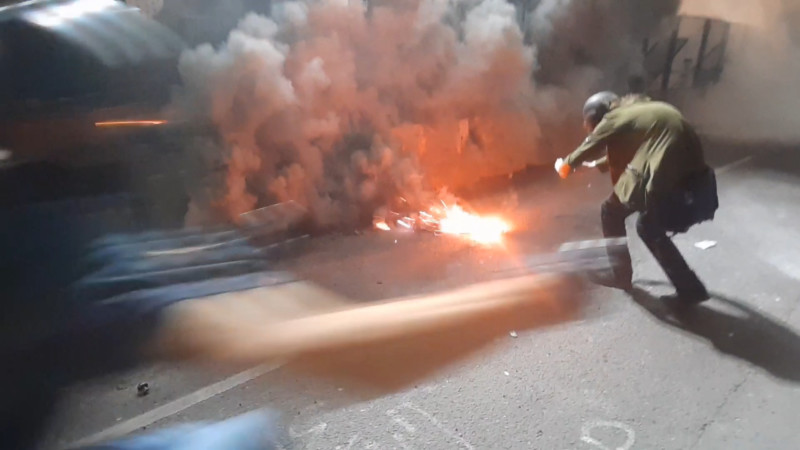On July 11, Garrison Davis was in downtown Portland, pointing his iPhone camera across a street at a group of roughly thirty law enforcement officers in camouflage. He heard a loud pop. He turned and saw a man who had been hit by an impact munition fall to the ground.
Davis, a seventeen-year-old film student, turned his still-recording phone toward the fallen figure and watched as a group of demonstrators rushed to the man’s side and carried him away. He then panned to the pool of blood left behind, and finally back from where the munition had come, to the federal agents who stood on and watched.
From behind a tree, Davis posted the video to Twitter. Within an hour, local news stations were asking him for permission to broadcast the video on their late-night newscasts. “What is your rate?” Davis asked.
The footage—viewed on Twitter almost half a million times now—was purchased by ABC and NBC, as well as several local news stations. It compelled more demonstrators to join protests downtown, and state and local leaders to publicly condemn the actions of federal law enforcement officers dispatched to Portland by President Trump and demand their withdrawal.
Davis began covering the Black Lives Matter demonstrations in Portland in late May, as protests swept the nation following the death of George Floyd. “I thought something big would probably happen in Portland, and I knew that someone should be filming everything up to that point,” Davis says. “Either the protesters were going to do something massive and influential on a global scale, or the police response would be extremely brutal.”

Garrison Davis leans into a tear gas canister with his iPhone camera. Photo courtesy of Laura Jedeed.
Much of the Portland protest footage we have seen has come from Davis or other members of the so-called Portland Press Corps—a group of roughly twenty local journalists. The name began as a joke, says Sergio Olmos, a freelance journalist who currently works with Oregon Public Broadcasting. However, once federal agents arrived, so did the national news spotlight. “Portland Press Corps became a way to say, Here are the locals who’ve been covering this for weeks,” Olmos says.
The group came up with a standardized pay scale—from $250, for up to fifteen seconds of footage, to $500 for between thirty and sixty seconds—to avoid being lowballed or pitted against one another.
They have been a vital resource. With the covid pandemic and a looming recession, news organizations everywhere have been forced to more carefully scrutinize their budgets.
“Media companies that weren’t local to the community were relying on social media footage in order to report on the most recent developments,” says Jareen Imam, director of NBC News Social Newsgathering, over email. Imam’s team has licensed several of Davis’s videos. “Especially because it takes time to deploy reporting crews, plus the threat of the pandemic,” she said.
The messages from eager producers looking to license content have slowed considerably. But members of the Portland Press Corps are still out in force.
Mickey Osterreicher, general counsel for the National Press Photographers Association, said independent freelancers often provide a lot of the video coverage from high-conflict zones like parts of the Middle East and Africa, where networks may be more reluctant to send their own reporters. In the case of Portland, “I don’t know that there’s this conscious decision to not send their own people there, but certainly everybody’s got a camera, everybody’s got a cellphone. It’s not like news networks need to go out there with tens of thousands of dollars in equipment anymore.”
National networks have used Portland Press Corps footage to underscore the severity of law enforcement actions against protesters, or to counter efforts to tell a different story. When Portland mayor Ted Wheeler took to CNN to decry the heavy-handed response of federal agents, the network showed footage taken by Tuck Woodstock, depicting the night rioters broke in to the Portland Police Association building and lit a desk on fire. When Department of Homeland Security secretary Chad Wolf appeared on Fox News to defend his officers’ actions, the channel showed Olmos’s footage of tear gas and flash-bangs.
With protests sustained over more than seventy consecutive nights, these independent journalists say the continuous coverage has begun to take its toll.
Laura Jedeed, whose clip showing fires from the protest site was purchased by Storyful, is still healing from a rubber bullet to the leg. A close-range shot by a pepper ball left her with a bruised and swollen wrist. And after being shoved by a police officer to the ground, Jedeed said, she’s had difficulty walking. “It’s been a rough month,” she said.
A journalist who began her career last year covering the alt-right, Jedeed said she was contacted by several news organizations that wanted to use her clips for free, most of which she turned down. “I guess I feel like, if I’m taking these risks, I should be compensated,” Jedeed said.
With federal agents now out of sight, the national spotlight has lifted, and the Portland protests have tapered back to levels seen before the federal government’s surge of agents. The messages from eager producers looking to license content have slowed considerably. But members of the Portland Press Corps are still out in force, on the front lines, documenting clashes between demonstrators and local police.
“What’s happening in Portland hasn’t stopped,” Davis said, speaking to CJR from the site of a recent demonstration.
“People are still here protesting the police, and police are still being brutal,” he said. “And that’s going to continue long after the national media pulls out.”
ICYMI: How protesters across the country are keeping informed
Deborah Bloom is a freelance journalist based in Portland, Oregon, who covers breaking news and stories about mental health, culture, and the environment.

